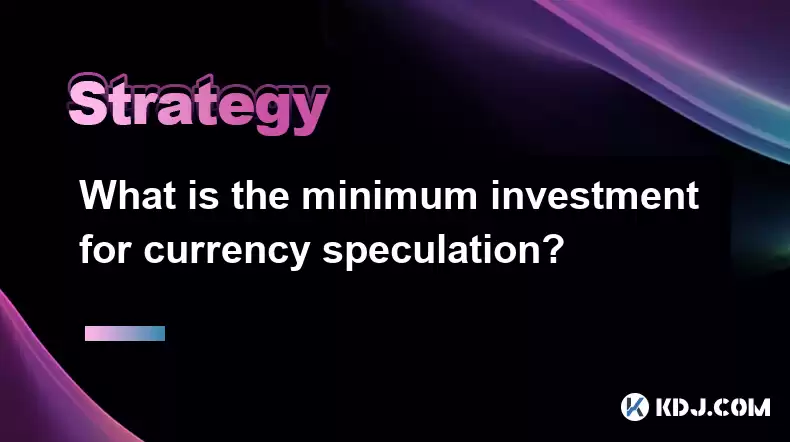-
 bitcoin
bitcoin $122659.385674 USD
0.52% -
 ethereum
ethereum $4484.113342 USD
-0.09% -
 bnb
bnb $1304.229256 USD
-0.85% -
 tether
tether $1.000204 USD
-0.03% -
 xrp
xrp $2.860636 USD
-0.51% -
 solana
solana $227.288799 USD
2.36% -
 usd-coin
usd-coin $0.999805 USD
0.01% -
 dogecoin
dogecoin $0.252837 USD
1.18% -
 tron
tron $0.341149 USD
1.12% -
 cardano
cardano $0.830507 USD
0.33% -
 hyperliquid
hyperliquid $45.792319 USD
0.04% -
 chainlink
chainlink $22.422164 USD
1.55% -
 ethena-usde
ethena-usde $1.000283 USD
0.01% -
 sui
sui $3.511389 USD
0.83% -
 stellar
stellar $0.385276 USD
-0.44%
What is the minimum investment for currency speculation?
Setting minimum investment levels for currency speculation varies across trading platforms, influenced by factors like platform regulations, cryptocurrency value, and risk management strategies.
Jan 07, 2025 at 09:55 pm

- Crypto Trading Minimums Vary by Platform
- Setting a Budget for Currency Speculation
- Understanding Fees and Spreads
- Leveraging Options and Margin Trading
- Minimizing Risk with Stop-Loss Orders
The minimum investment for currency speculation, also known as cryptocurrency trading, can vary significantly depending on the trading platform and the specific cryptocurrency being traded. Here's an overview of how these factors affect minimum investment requirements:
1. Trading Platform Minimums:- Centralized Exchanges: These platforms typically set minimum order sizes for each cryptocurrency, ranging from a few dollars to hundreds or even thousands of dollars. For instance,Binancehas a minimum order size of 0.001 BTC (approx. $20 as of May 2023).
- Decentralized Exchanges (DEXs): DEXs generally offer more flexibility, allowing traders to set their own minimum order sizes. However, some DEXs may have restrictions based on liquidity and network congestion.
- The minimum investment also depends on the value of the cryptocurrency being traded. For example, trading a high-priced cryptocurrency like Bitcoin requires a higher minimum investment compared to a lower-priced altcoin like Dogecoin.
- Trading fees and spreads can impact the minimum investment. Fees are charged on each trade, while spreads refer to the difference between the buying and selling prices. Higher fees and wider spreads can reduce the potential returns on smaller investments.
- Some platforms offer options and margin trading, which allow traders to leverage their positions. This can magnify both potential profits and losses, enabling smaller investments to trade larger volumes. However, it also increases the risk of significant losses.
- To manage risk, traders can utilize stop-loss orders. These orders automatically sell a cryptocurrency when it reaches a predefined price level, limiting potential losses.
- What is the best platform for beginners with low minimums?
- Many platforms offer low minimums suitable for beginners, such as Binance, Coinbase, and Kraken.
- Can I trade cryptocurrencies with less than $1?
- Some DEXs may allow trades with minimal amounts, but it's essential to consider trading fees and liquidity.
- What are the risks of currency speculation with a small investment?
- Losses can exceed the initial investment, especially with leveraged trading. Careful risk management is crucial.
- Is it possible to make significant profits with a small investment?
- While it's possible, it's highly speculative and requires a combination of luck and skilled trading. Starting with a small investment and gradually increasing it as experience grows is recommended.
- How can I reduce my trading fees?
- Consider using platforms with lower fees, taking advantage of discounts for higher trading volumes, and utilizing limit orders instead of market orders.
Disclaimer:info@kdj.com
The information provided is not trading advice. kdj.com does not assume any responsibility for any investments made based on the information provided in this article. Cryptocurrencies are highly volatile and it is highly recommended that you invest with caution after thorough research!
If you believe that the content used on this website infringes your copyright, please contact us immediately (info@kdj.com) and we will delete it promptly.
- Bitcoin Cash, Trust, and Prime Brokers: A New Era of Transparency?
- 2025-10-10 06:45:16
- Ripple's Stablecoin Expansion: Bahrain, Web3, and RLUSD's Big Push
- 2025-10-10 06:25:13
- Memecoin Trader's Success: Riding the Crypto Wave Like a Pro
- 2025-10-10 06:25:13
- Dogecoin, Shiba Inu, AlphaPepe: Meme Coin Mania Heats Up!
- 2025-10-10 07:05:14
- Chainlink, Jovay Network, and Integration: A New Era of Decentralized Finance?
- 2025-10-10 07:05:14
- Aave & Blockdaemon: Powering Institutional DeFi Participation
- 2025-10-10 06:45:16
Related knowledge

Practical parameter settings for a Bitcoin multi-timeframe moving average system
Sep 18,2025 at 10:54pm
Optimizing Timeframe Combinations for Bitcoin Trading1. Selecting appropriate timeframes is crucial when building a multi-timeframe moving average sys...

How can I filter out false breakouts in Dogecoin high-frequency trading?
Sep 22,2025 at 01:00am
Understanding False Breakouts in Dogecoin Trading1. A false breakout occurs when Dogecoin's price appears to move beyond a defined support or resistan...

Techniques for identifying tops and bottoms in the Bitcoin on-chain NVT model
Sep 20,2025 at 07:54pm
Understanding the NVT Model in Bitcoin Analysis1. The Network Value to Transactions (NVT) ratio is often described as the 'P/E ratio' of the cryptocur...

What does the surge in open interest in Bitcoincoin futures mean?
Sep 20,2025 at 11:18pm
Understanding the Surge in Dogecoin Futures Open Interest1. A surge in open interest within Dogecoin futures indicates a growing number of active cont...

How can I use the Ethereum USDT premium to gauge market sentiment?
Sep 18,2025 at 11:55pm
Understanding the Ethereum USDT Premium1. The Ethereum USDT premium refers to the price difference between USDT (Tether) traded on Ethereum-based plat...

What should I do if Ethereum staking yields decline?
Sep 20,2025 at 06:18am
Understanding the Causes Behind Declining Ethereum Staking Yields1. The Ethereum network transitioned to a proof-of-stake consensus mechanism with the...

Practical parameter settings for a Bitcoin multi-timeframe moving average system
Sep 18,2025 at 10:54pm
Optimizing Timeframe Combinations for Bitcoin Trading1. Selecting appropriate timeframes is crucial when building a multi-timeframe moving average sys...

How can I filter out false breakouts in Dogecoin high-frequency trading?
Sep 22,2025 at 01:00am
Understanding False Breakouts in Dogecoin Trading1. A false breakout occurs when Dogecoin's price appears to move beyond a defined support or resistan...

Techniques for identifying tops and bottoms in the Bitcoin on-chain NVT model
Sep 20,2025 at 07:54pm
Understanding the NVT Model in Bitcoin Analysis1. The Network Value to Transactions (NVT) ratio is often described as the 'P/E ratio' of the cryptocur...

What does the surge in open interest in Bitcoincoin futures mean?
Sep 20,2025 at 11:18pm
Understanding the Surge in Dogecoin Futures Open Interest1. A surge in open interest within Dogecoin futures indicates a growing number of active cont...

How can I use the Ethereum USDT premium to gauge market sentiment?
Sep 18,2025 at 11:55pm
Understanding the Ethereum USDT Premium1. The Ethereum USDT premium refers to the price difference between USDT (Tether) traded on Ethereum-based plat...

What should I do if Ethereum staking yields decline?
Sep 20,2025 at 06:18am
Understanding the Causes Behind Declining Ethereum Staking Yields1. The Ethereum network transitioned to a proof-of-stake consensus mechanism with the...
See all articles


























![🚨IS VECHAIN (VET) A DEAD COIN ?? PRICE ANALYSIS [GET READY NOW] 🚨IS VECHAIN (VET) A DEAD COIN ?? PRICE ANALYSIS [GET READY NOW]](/uploads/2025/10/09/cryptocurrencies-news/videos/vechain-vet-dead-coin-price-analysis-ready/68e7b200b067b_image_500_375.webp)















































